Overview
An OEM purlin roll forming machine is a specialized industrial equipment system used to continuously mass produce long length metal purlins and girts from coiled steel feedstock for use in original equipment manufactured steel buildings and structures.
Purlins act as structural Z, C or U-shaped roof and wall framing members that support exterior covering materials in metal building systems. Roll formed purlin sections optimize strength-to-weight rations with their vertical web and flange cross-sectional shape.
This guide provides a comprehensive overview of OEM purlin roll former technology, including:
- Machine types and components
- The purlin roll forming process
- Design factors and building standards
- Purlin framing applications
- Cost analysis
- Comparisons with other framing methods
- Leading global manufacturers
Gaining technical insight into OEM purlin roll former capabilities and structural framing assists engineers, contractors and architects evaluating optimized building solutions.
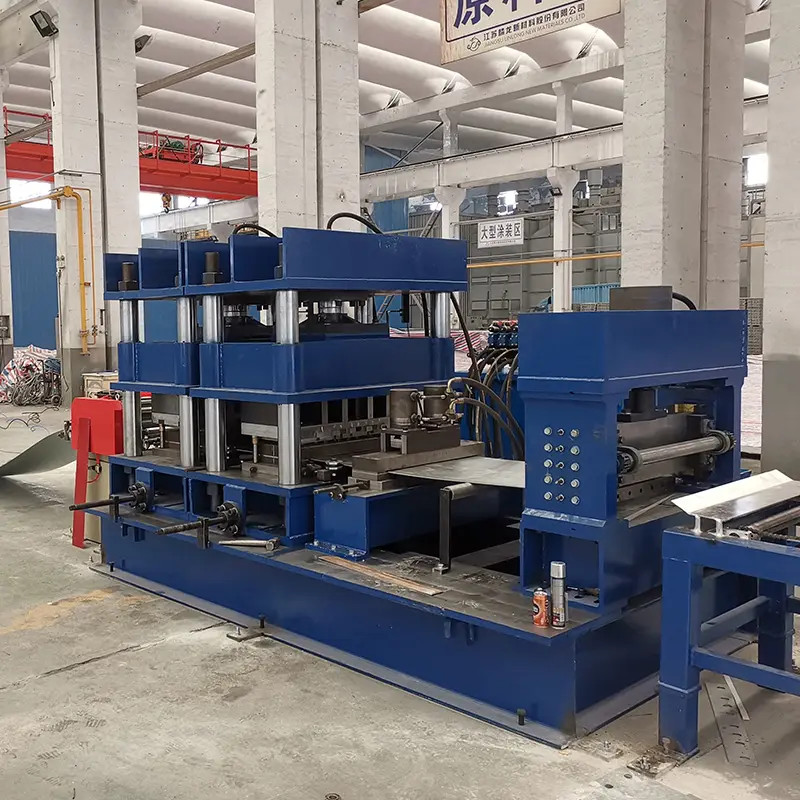
Types of OEM Purlin Roll Forming Machines
There are two primary machine configurations used for high volume OEM purlin production:
Pyramid-Type Purlin Roll Formers
- Typically 10-16 forming stations in decreasing diameter tiers
- Compact layout, smaller footprint
- Slower production speeds
Inline Purlin Roll Formers
- Stations horizontally inline
- Longer line lengths
- High volume capacity
- Faster cycle times
Main Components of a Purlin Roll Former
A typical OEM purlin roll forming line integrates these key sections:
Coil Payoff Reel
- Holds raw steel coil
- Powered unwind
Entry Guides
- Straighten and align strip
- Optimize material feed
Accumulator / Bridle
- Creates back tension zone
- Smooths flow variations
Forming Stations
- Progressive die rollers shape strip
- Number & type determine profile
Cutter
- Pneumatic or servo shear
- Trims finished purlins
Exit Conveyor Table
- Transfers finished lengths
- Supports long products
Automation Controller
- Touchscreen HMI
- Stores recipes
- Production data feedback
How Purlin Roll Forming Machines Work
The OEM purlin roll forming process shapes steel coil strip into C or Z-shaped roof and wall framing sections by bending and forming the feed material incrementally as it passes through a series of roller die stations:
- Powered coil payoff reel feeds raw coiled steel into entry guides
- Guides align strip and feed into initial roller stations
- Rolling dies at each station make gradual precision bends
- Strip exits each stand slightly more formed
- Finished purlin profile emerges at end of line
- Pneumatic shear cuts to length
- Exit conveyor tables transfer finished lengths
The number of roller die stands determines possible purlin profile complexity. Quick change tooling allows fast production changeovers.
-
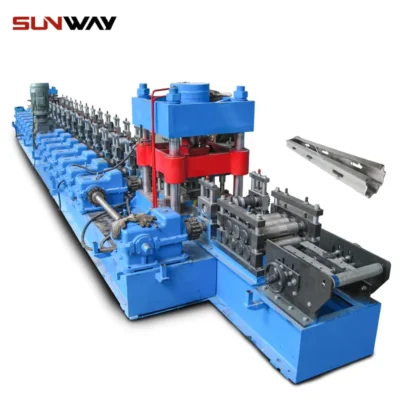 Vineyard Post Roll Forming Machine
Vineyard Post Roll Forming Machine -
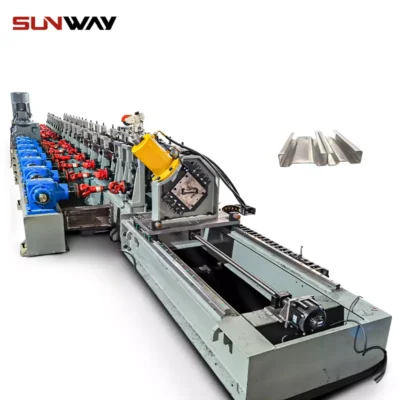 Auto Size Changeable Sigma Purlin Roll Forming Machine
Auto Size Changeable Sigma Purlin Roll Forming Machine -
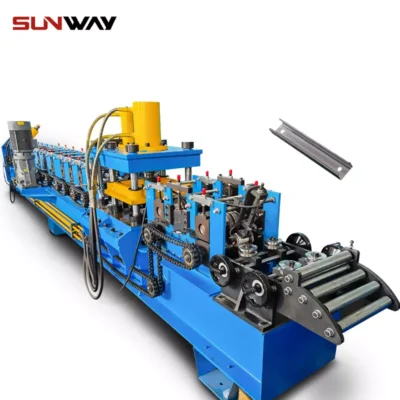 C Section Bracing Omega Storage Rack Upright Post Roll Forming Machine
C Section Bracing Omega Storage Rack Upright Post Roll Forming Machine -
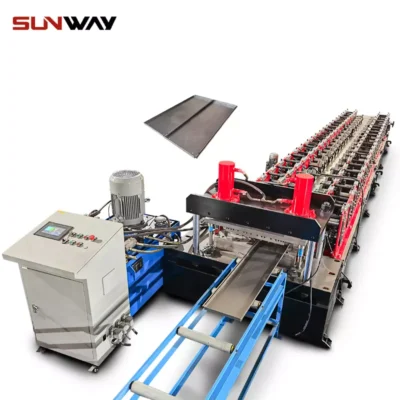 Steel Box Plate Making Roll Forming Machine
Steel Box Plate Making Roll Forming Machine -
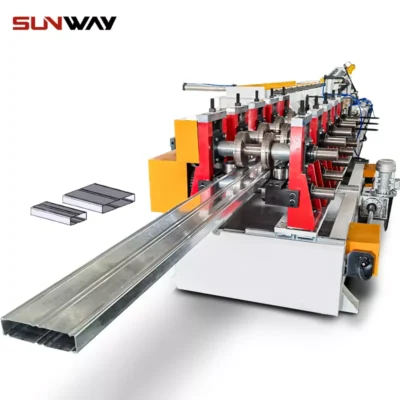 Box Beam Steel Roll Forming Machine For Shelf Column
Box Beam Steel Roll Forming Machine For Shelf Column -
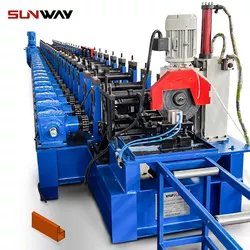 Pallet Racking Step Beam P Beam Roll Forming Machine
Pallet Racking Step Beam P Beam Roll Forming Machine -
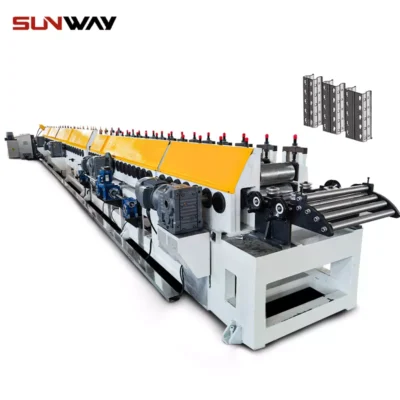 Warehouse Shelf Upright Roll Forming Machine
Warehouse Shelf Upright Roll Forming Machine -
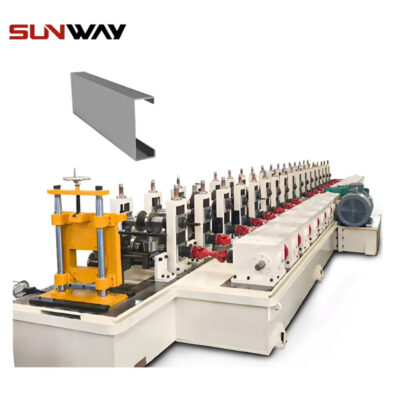 PV Mounting Bracket C Shape Profile Roll Forming Machine
PV Mounting Bracket C Shape Profile Roll Forming Machine -
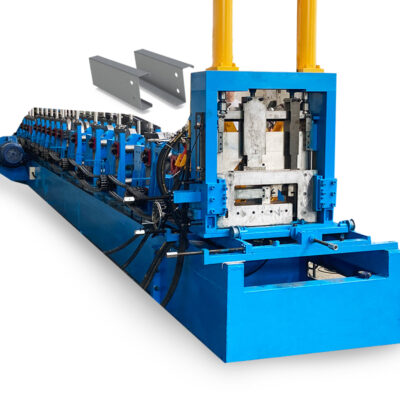 C Z Purlin Channel Cold Roll Forming Machine Full Auto Galvanized Steel Profile
C Z Purlin Channel Cold Roll Forming Machine Full Auto Galvanized Steel Profile
Key Design Factors for Purlin Roll Forming
Equipment specifiers evaluate numerous characteristics when selecting OEM purlin roll formers:
Building Type
- Pre-engineered steel structures
- Agricultural & commercial spans
- Residential metal roofing
Purlin Type
- Zee, Zed, Sigma
- Narrow flange Cee
- Structural tees
Material
- Low carbon steel
- High strength steel
- Galvanized coatings
Thickness
- 16 gauge to 7 gauge
- 1.2mm to 4mm+
Profile Height
- 75mm to 400mm+
- 3” to 18”+
Line Speed
- 10 to 35 m/min
- 33 to 115 ft/min
Changeover
- Quick change tooling
- Secondary fab stations
Framing Standards for OEM Purlins
While often custom engineered for specific buildings, these standards guide commercial purlin designs:
| Standard | Description |
|---|---|
| AISI S100 | North American cold-formed steel framing |
| AS/NZS 4600 | Australian / New Zealand cold-formed steel structures |
| BS 5950 | British cold rolled steel sections |
| EN 1993-1-3 | European cold-formed steel structural framing |
| IS 801 | Indian standard purlin sections |
Typical Purlin Framing Applications
Common structural framing applications utilizing OEM roll formed steel purlins include:
Roof Purlins
- Metal building roofing support
- Standing seam roofing
- Single skin systems
Wall Girts
- Exterior metal panel backing
- Curtain wall framing
- Interior divide framing
Platform Framing
- Supporting floors
- Structural bridging
- Platform roofs
Structural Racking
- Warehouse racks
- Mezzanines
- Equipment platforms
Agricultural Buildings
- Pole barns
- Grain bin rings
- Storage sheds
Purlin Specifications
| Metric | Typical Range |
|---|---|
| Height | 75 mm – 400 mm |
| Flange Width | 30 mm – 100 mm |
| Thickness | 1.5 mm – 4 mm |
| Length | 2 m – 13 m |
| Load | 3 kN/m – 10 kN/m |
| Span | 1.5 m – 8 m |
Leading OEM Purlin Roll Former Manufacturers
Top international OEM purlin roll former producers include:
| Company | Location |
|---|---|
| Formtek | USA |
| Epicenter Machinery | China |
| BOTOU Xianfa | China |
| Gasparini | Italy |
| Metform | Turkey |
Pricing
| Machine | Average Cost (USD) |
|---|---|
| Basic Pyramid Roll Former | $92,000 |
| Inline 20-Station Machine | $185,000 |
| High Capacity Servo Line | $430,000 |
| Purlin | Average Cost Per Foot (USD) |
|---|---|
| 12” 18 Gauge Zee | $1.15 |
| 8” 14 Gauge Cee | $1.75 |
| 4” 11 Gauge Sigma | $2.40 |
Advantages of OEM Purlin Roll Forming
Benefits
- High production speeds
- Precision tolerances
- Quality consistency
- Minimal fabrication
- Lower material cost
- Reduced building construction time
Limitations
- High machine capital costs
- Mainly long, straight shapes
- Can require secondary punching
- Fixed tooling less flexible
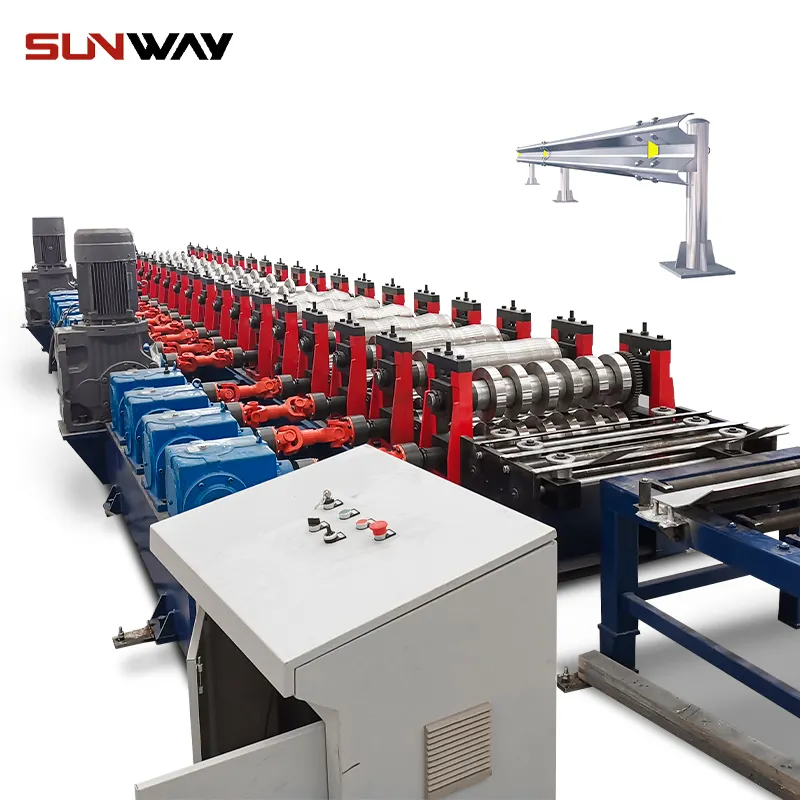
FAQ
What is the maximum length of OEM roll formed purlins?
Standard exit conveyor tables allow continuous forming of purlins up to 40′ (12 m). Custom extra long beds can produce sections approaching 65′ (20 m).
What metals can use roll forming for purlins?
All common building steels including low carbon, high strength alloy steels, corrosion resistant alloys as well as lightweight aluminum framing grades.
What if secondary holes or clips are needed in the purlins?
Inline punching presses, drilling machines and clip insertion equipment can be integrated on the exit conveyor to add holes or mounting features.
What is the thickest gauge purlin an OEM roll former can produce?
Average max thickness is around 7 gauge steel or 4mm plate. Heavy duty custom machines can produce structural shapes from 3 gauge steel and beyond.
Frequently Asked Questions (FAQ)
1) Can an OEM purlin roll forming machine switch between C, Z, and Sigma profiles without changing the whole line?
- Yes. Modern OEM purlin roll forming machines support quick-change cassettes or auto-size tooling that swaps out roll sets and adjusts web/flange widths via servo-actuated stands. Changeovers can be under 15–30 minutes on advanced lines.
2) How do I size motor power and line speed for 3 mm high-strength galvanized steel?
- For 3 mm HSS (≥350 MPa), lines typically use 22–45 kW main drives and run 15–30 m/min depending on profile depth and punching density. Accumulators and bridle systems are recommended to maintain tension during punching and cutting. Consult AISI S100 or EN 1993-1-3 for structural limits and required tolerances.
3) What tolerances are typical for OEM C/Z purlins?
- Common production tolerances: web/flange ±0.5–1.0 mm, angle ±0.5°, straightness ≤1.5 mm per meter, bow ≤3 mm per 3 m, hole-to-edge ±0.5 mm (with servo punching). Verify against project specs and local standards (AISI S100, AS/NZS 4600, EN 1993-1-3).
4) Do I need inline punching or can I post-process holes?
- Inline servo punching improves throughput, positional accuracy, and reduces WIP. Post-process turret punching or drilling increases handling costs and risk of distortion. For high-mix OEM orders, consider modular punching stations with programmable tooling.
5) What quality control checks should run per shift?
- Coil cert verification (grade, coating), first-article dimensional audit, hardness and coating thickness spot checks, inline vision for hole pattern, cut-length verification, and periodic straightness/bow checks. Log data via the HMI/MES for traceability (ISO 9001/EN 1090 compliance).
2025 Industry Trends
- Shift to high-strength, low-alloy (HSLA) coils and ZAM/Al-Zn coatings to extend service life in aggressive environments.
- Growth of auto-adjust (size-changeable) C/Z purlin lines with recipe-driven servo stands to reduce changeover downtime in OEM operations.
- Integration of OPC UA/MQTT connectivity and edge analytics for predictive maintenance and scrap reduction.
- Safety and compliance: more OEMs adding EN ISO 14120 guarding, PL d safety circuits, and e-stop zoning.
- Regionalization of coil sourcing and just-in-time slit coil inventory to mitigate logistics volatility.
2025 Key Metrics for OEM Purlin Roll Forming Machines
| Metric | 2023 Typical | 2025 Leading Edge | Impact on OEM Purlin Roll Forming Machine ROI |
|---|---|---|---|
| Changeover time (C↔Z, width/depth) | 45–60 min | 8–15 min | +6–10% OEE; faster small-batch runs |
| Scrap rate (startup + steady) | 3.0–4.5% | 1.2–2.0% | Material savings on HSLA coils |
| Energy use (kWh/ton) | 95–120 | 70–90 | Lower operating cost, ESG alignment |
| Predictive maintenance adoption | 20–30% of lines | 55–65% of new lines | Fewer unplanned stops |
| Inline punching accuracy (± mm) | ±0.7–1.0 | ±0.3–0.5 | Better fit-up, reduces rework |
| Typical line speed (m/min, 2–3 mm) | 15–25 | 20–35 | Higher throughput with servo shear |
Sources: World Steel Association 2025 outlook (https://worldsteel.org), AISI S100 updates (https://www.awc.org/standards/aisi), CEN EN 1993-1-3 developments (https://standards.cen.eu), vendor whitepapers (Formtek, Gasparini, Metform).
Latest Research Cases
Case Study 1: Auto-Size C/Z Line Retrofit for HSLA Coils (2025)
- Background: An OEM building systems producer in the EU struggled with 3–4% scrap and 50-minute changeovers on 1.6–3.2 mm galvanized HSLA purlins.
- Solution: Retrofitted servo-driven cassette stands, closed-loop length control with encoder wheel, and OPC UA data layer feeding a predictive bearing wear model.
- Results: Changeover reduced to 12 minutes; scrap to 1.6%; OEE up 8.4%; payback in 11 months. Dimensional Cp/Cpk improved >1.33 on flange width and hole positions. Compliance aligned with EN 1993-1-3 tolerances.
Case Study 2: Integrated Inline Punching and Vision QC for OEM Z-Purlins (2024)
- Background: North American OEM needed rapid variant production with dense hole patterns for solar canopies.
- Solution: Added servo turret punching with quick-change tooling and AI vision for hole presence/position; synchronized with flying shear.
- Results: Throughput +22% at 28 m/min; hole defects down 72%; rework time cut by 40%. Met AISI S100 and ASTM A653 coating integrity criteria.
Expert Opinions
- Dr. Helen Park, Senior Materials Engineer, World Steel Association
- Viewpoint: “HSLA and Al-Zn coatings are delivering longer life purlins without weight penalties. For OEM purlin roll forming machines, consistent coil mechanical properties and slit edge quality are now as critical as tooling geometry.” (https://worldsteel.org)
- Marco Bellini, CTO, Gasparini Industries
- Viewpoint: “Auto-size changeover with servo stands and real-time analytics has moved from nice-to-have to standard. The biggest ROI lever in 2025 is predictive maintenance on bearings and gearboxes tied to vibration and thermal trends.” (https://www.gasparini.com)
- Laura Chen, Director of Manufacturing Systems, Formtek Group
- Viewpoint: “Inline punching with digital twins lets OEMs validate hole patterns and cut lengths virtually, minimizing first-article scrap. We’re seeing customers achieve sub-0.5 mm positional accuracy at 30+ m/min.” (https://www.formtekgroup.com)
Practical Tools/Resources
- AISI S100 (North American Specification for Cold-Formed Steel): https://www.awc.org/standards/aisi
- EN 1993-1-3 (Eurocode 3, Cold-formed members): https://standards.cen.eu
- AS/NZS 4600 (Cold-Formed Steel Structures): https://www.standards.govt.nz
- World Steel Association Market Outlooks: https://worldsteel.org
- Coil Calculator and Bend Allowance Tool (The Fabricator): https://www.thefabricator.com
- OPC UA for Industrial Interoperability: https://opcfoundation.org
- Gasparini Roll Forming Knowledge Base: https://www.gasparini.com/en/knowledge
- Formtek Technical Resources: https://www.formtekgroup.com/resources
- NIST Smart Manufacturing resources: https://www.nist.gov/el/smart-manufacturing
Last updated: 2025-10-23
Changelog: Added 5 new FAQs; inserted 2025 industry trends with performance table; provided two 2024/2025 case studies; included expert opinions with sources; added practical tools/resources
Next review date & triggers: 2026-03-31 or earlier if AISI/EN standard revisions publish, HSLA coil availability shifts, or predictive maintenance benchmarks change by >10%
